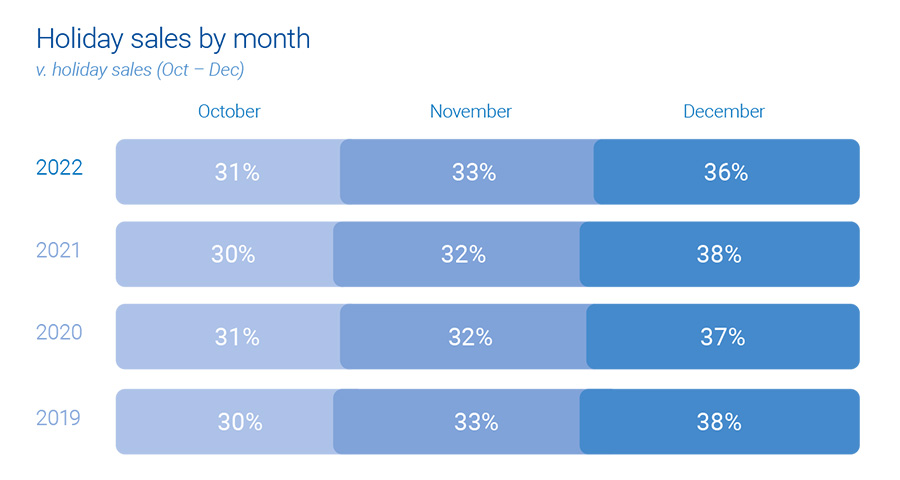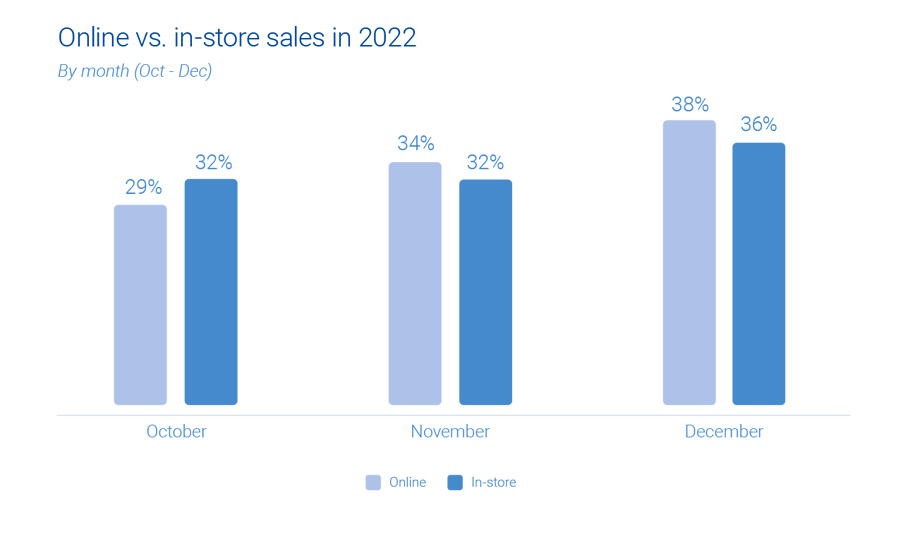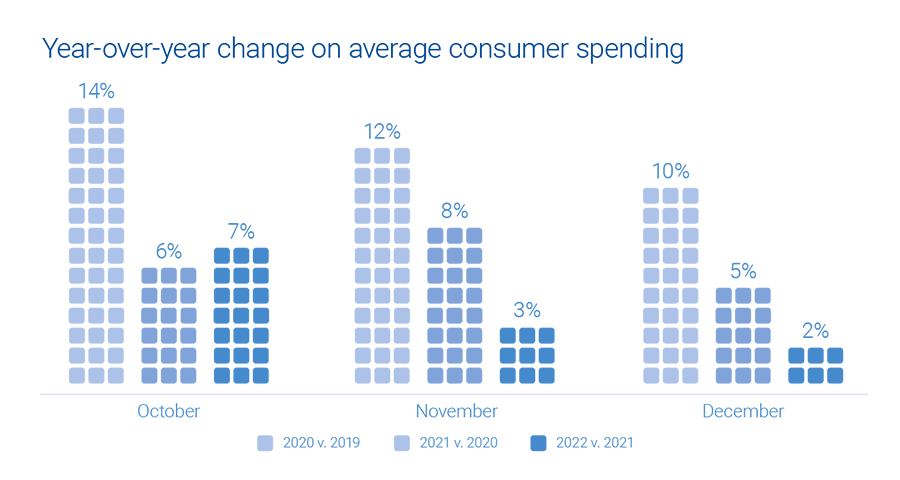
The holiday season is just around the corner, and retailers and marketers are gearing up for the busiest shopping period of the year. It’s crucial to understand how consumer behavior is evolving and what emerging trends to expect. Experian’s 2023 Holiday spending trends and insights report analyzes recent trends, consumer spending habits, and anticipates what’s to come in 2023 to help you deliver a top-notch shopping experience this holiday season.
In this blog post, we’ll cover three key insights from our report.
1. Consumers are shopping earlier
It’s no secret that December has always been the go-to month for consumers when it comes to holiday spending. However, holiday shopping now starts earlier, particularly with online sales.

This can be attributed to a surge in promotions and deals, enticing shoppers to open their wallets ahead of time, giving a significant boost to holiday sales. Notably, Cyber Week sales have proven to be an influential factor, accounting for 8% of total consumer holiday spending.
Experian tip
Reach the right shoppers with your promotions with sell-side targeting. This powerful approach gives you control over where your ads are placed while ensuring maximum visibility through direct connections with publishers. Whether on mobile, web, or CTV, this seamless ad experience will engage your audience effectively.
2. Online sales are on the rise
The popularity of online holiday sales is continuously growing, surpassing in-store shopping. There has been a consistent 1% year-over-year increase in online sales, while in-store sales have seen a 1% decrease.
“It’s easier for consumers to comparison shop for large ticket items online that they might find at a mass retailer or office supply store. Consumers prefer to have larger, bulkier items shipped directly to their home for minimal cost. By shopping online, consumers can save time since they don’t need to wait in checkout lines.”
Anna Liparoto, Sr. Account Executive, Retail & CPG

Although online sales currently make up only one-third of all holiday shopping, there is immense potential for further expansion. Mass retailers and office, electronics, and games industries particularly excel in online holiday sales. While in-store purchases remain the primary choice for holiday shoppers, consumer online and offline activities intersect before the final purchase.
Experian tip
Take advantage of the surge in online shopping by diversifying your marketing channels. An agnostic identity graph can bring together device and media data, capturing valuable user insights. By gaining a holistic view of your target audience, you’ll be able to optimize your ad spend and allocate resources effectively, ultimately boosting your return on investment.
“Omnichannel targeting during the upcoming holiday season will continue to prove to be the best way to reach scale and maximize ROI across all marketing channels.”
Joe LigÉ, Head of Enterprise Demand Partnerships
3. 2023 holiday spending will be on par with 2022
During the holiday season in 2022, consumer spending showed an anticipated increase, although the growth rate was slightly lower compared to previous years. October saw a surge in average consumer spending, indicating a swift response to early discounts and promotions offered by retailers.

As the holiday season progressed, holiday spending gradually slowed down and reached a level similar to that of the previous year. Overall, there was a modest 2% growth. Looking into the future, if economic conditions remain stable in the second half of 2023, we can expect holiday spending to align with the figures from last year.
Experian tip
To truly maximize impact, consider data enrichment. By diving deeper into your target audience’s preferences and behaviors, you can better tailor your strategies and seamlessly integrate the enriched data across various channels. This allows you to unlock the true potential of your ad inventory, creating more meaningful connections with your audience.
Download our 2024 report
Get ready for the holiday shopping season with Experian’s 2024 Holiday spending trends and insights report. Inside you’ll find:
- Analysis of past trends and what they mean for 2024
- Exclusive predictions for the upcoming holiday season
- The top audiences to activate this holiday season
To access to all of our predictions for this year’s holiday shopping season, download our 2024 Holiday spending trends and insights report today.
Latest posts

This article is an excerpt from Experian Marketing Services’ 2016 Digital Marketer Report. Download the full report to discover more insights and trends for the upcoming year! Support your mobile app with other mobile marketing initiatives Marketers are fascinated by mobile, and for good reason. It’s increasingly the device of choice for consumers. SMS and MMS messages, push notifications and the app inbox all offer marketers the ability to communicate directly with customers in a way that is immediate and friendly. Yet there seems to be an interest gap between developing mobile apps and building other mobile initiatives. In this year’s Digital Marketer Survey, 53 percent of respondents indicated that they plan to integrate a mobile app into their mobile marketing program in 2016, compared with only 40 percent for other mobile programs like SMS or MMS. Without a doubt, well-designed apps can be incredibly useful for building the brand relationship. Good apps focus on improving the customers’ experience by making their lives easier – by tailoring the content to their personal experience or lessening the number of steps it takes for them to perform an action. In service-based industries, apps can alleviate the need for in-store or in-branch services, helping companies become more lean and efficient. For example, consumer bank apps have redesigned the experience of depositing a check or transferring money between accounts, allowing them to cater to their customers’ needs faster and more efficiently than ever possible through a physical teller. That said, mobile apps are also time- and resource-intensive to develop, especially if they are well designed. Other mobile initiatives, like SMS and MMS text messaging programs or mobile wallet, require less investment to create and maintain. Additionally, imagine if every marketer who shared a plan to build an app actually followed through. That would mean a lot of competition for customers’ limited phone space. This is why I find the interest gap fascinating. Mobile apps are useful, but they should be part of a cohesive mobile strategy, supported with other mobile programs like SMS and MMS messaging that are less costly and can serve as an effective alternative for communicating with customers who have push notifications disabled, are inactive users, don’t have compatible phones or simply haven’t downloaded your app. Business needs can dictate mobile marketing strategy This concept is especially important for brands that use the mobile space to communicate service-related or operational messages, such as shipping and delivery notifications, fraud alerts or travel delay notices that require immediacy. These kinds of messages are time-sensitive and valuable. Customers who don’t have your app will benefit from their receipt if you offer it to them via another channel. Of course, it’s important to remember that not every business fits usage of SMS and MMS or app programs. Consider the needs and preferences of your unique customers to determine the need to develop a mobile program. After all, mobile experiences that are not well thought through may be more damaging than beneficial. According to a Google study of smartphone users, 66 percent of consumers will take negative action if a mobile site or app doesn’t satisfy their needs, such as being less likely to return to the site or app (40 percent) or purchase products from the company in the future (28 percent). Ultimately, if you’re investing in a mobile app experience, don’t forget about the power of a complimentary text message strategy. Mobile app marketing and text messages can go hand in hand. Develop an SMS experience that proves the value of your brand in the mobile space. Once you do, your customers and prospects will be more likely to believe in the value of your full app experience.

Cross-screen marketing tech firm, Tapad, drove unified campaign; partnered with Statiq to measure cross-screen impact on in-store visits LONDON, March 8, 2016 /PRNewswire/ — Carat North completed the UK's most comprehensive digital campaign with Tapad, the leader in cross-device marketing technology and now a part of Experian. Coupled with location-based audience data from Statiq, this marks the first time a UK-company has measured the impact of unified, cross-screen campaign on in-store visits. Carat North served display and video ads to grocery shoppers for the leading retailer ASDA from August through October. During the campaign, Tapad utilized Statiq's audience data to measure which users visited a store after being exposed* to the campaign's ad on multiple devices. The digital campaign demonstrated a lift of 59% for in-store visits when users were exposed to ads on three devices over people who were shown an ad only on onescreen. Those who engaged with the ad were also 411% more likely to visit an ASDA store. Of those who were exposed to an ad, 248% were more likely to visit a store. Impressions served to mobile devices saw the highest success rate with an in-store visit lift of 67%. The campaign leveraged Tapad's proprietary technology, The Device Graph™, which Nielsen confirmed Tapad's cross device accuracy to be 91.2%, to serve ads sequentially on connected devices belonging to the same user. CARAT NORTH: "The ability to know which devices belong to our customer, coupled with the ability to deliver the right ad, and right message, wherever they are and on whatever device they're using, has been something this industry has long needed," said Steve Thornton, Digital Account Manager, Carat North. "We're impressed with the results that have come from the work with Tapad and Statiq for this media-first, and look forward to continuing to offer these solutions to clients like ASDA. Matching unified cross-device capabilities with real insights on campaign performance is an invaluable advantage in the marketing world." TAPAD: "This campaign is a perfect example of the capabilities of cross-device advertising," said Are Traasdahl, Founder and CEO, Tapad. "In addition to reaching users across devices, we're able to analyze campaign results and determine how different combinations of ad exposure, creative type or view frequency affected their decision to visit a location." STATIQ: "As a location data specialist, Tapad is our ideal partner – they are an industry leader and by working with them we are able to determine the impact unified messaging has on real world consumer behaviours," said Dean Cussell, Co-Founder of Statiq. "We believe this type of analysis will significantly aid brands in optimising future ad spend." About Carat North Carat North is a leading independent media planning & buying specialist in digital and non-traditional media solutions. Owned by global media group Dentsu Aegis Network, the Carat network is more than 6,700 people in 130 countries worldwide across 170 cities. Carat defined the sector when established as the world's first media independent in 1968 and is now Europe's largest media network, a position held for more than 15 years. For more information visit www.carat.co.uk About Tapad Tapad Inc. is a marketing technology firm renowned for its breakthrough, unified, cross-device solutions. With 91.2% data accuracy confirmed by Nielsen, the company offers the largest in-market opportunity for marketers and technologies to address the ever-evolving reality of media consumption on smartphones, tablets, home computers and smart TVs. Deployed by agency trading desks, publishers and numerous Fortune 500 brands, Tapad provides an accurate, unified approach to connecting with consumers across screens. In 2015, Tapad began aggressively licensing its identity management solution, the Tapad Device Graph™, and swiftly became the established gold-standard throughout the ad tech ecosystem. Tapad is based in New York and has offices in Atlanta, Boston, Chicago, Dallas, Detroit,Frankfurt, London, Los Angeles, Miami, Minneapolis, San Francisco and Toronto. TechCrunch called the powerhouse Tapad team "a hell of a list of entrepreneurs who created some of the most valuable online advertising companies of the last decade." Among Tapad's numerous awards: EY Entrepreneur of The Year (East Coast) 2014, among Forbes' Most Promising Companies two year's running, Deloitte's Technology Fast 500, Crain's Fast 50, Entrepreneur 360, Digiday Signal Award, iMedia ASPY Award, and a MarCom Gold Award. Read the full release here. *Tapad utilized Statiq's audience data to measure which users visited a store during, or within one month of, being exposed to the campaign's ad on multiple devices. Contact us today!

It’s the holiday season! For some, this is the time of year for family, friends and reflection. For the other 97 percent* of us, it’s time to shop! America’s obsession with Black Friday, Cyber Monday and the rest of the holiday shopping season has never been stronger. Or weaker? Or something? All I know is that you should be skeptical of anything you see regarding the Thanksgiving weekend performance. And now, I will tell you about the Thanksgiving weekend performance We’re not discussing revenue in this post. Instead, we’ll dive into the weekend’s email subject lines – more specifically, how “percent off” deals affected email open rates. As everyone knows, Black Friday and Cyber Monday are the days for deals. Juicy “percent off” offers motivate customers to buy, buy, buy. But is the conventional wisdom, that “a deep discount will get people to engage with my brand,” actually right? A few weeks ago, my counterpart in the UK published an analysis of how percentage off discounts influence open rates. Taking the cue from Karl, I wanted to expand this analysis into the U.S. market, paying special attention to Thanksgiving weekend. To begin, I gathered data on a few thousand mailings from our largest retail clients. To determine the baseline expected open rates, I averaged each brand’s performance in the 6 weeks prior to Black Friday. I then analyzed all the mailings sent on Black Friday and Cyber Monday, dividing the subject lines based on the appearance of a percentage off offer. Interestingly, percentage off offers were less prominent than I expected: And when percentages off were present… their values were all over the place: Higher volume doesn’t lead to improved performance Conventional wisdom would suggest that advertising a discount more frequently would lead to better performing discounts. The data, however, doesn’t support that idea. When I looked at volume distribution and relative performance for each advertised discount, I found a relatively strong negative correlation of -0.63. So the more frequently a discount was advertised, the worse it tended to perform. We can see this visually in the chart below: On average, advertising discounts did not significantly improve open rates. What happened? The first thing to note here is the wide spread in the data – some percentage off discounts worked very well! Overall, though, shouting about a discount wasn’t what convinced customers to open emails during the holidays. But maybe it wasn’t just the percentage off discounts that faltered this season – perhaps all opens were down? As you can see in the histogram above – this wasn’t the case. The average mailing not touting a percentage off discount did ever so slightly better than the baseline average. Still, the spread of data is very wide, with a lot of variation in results. It could be that the dispersion of results was a product of each brand’s initial baseline; brands that normally had great engagement would see positive gains for percentage off discounts while brands with poor engagement would see little to negative lifts, or vice versa. But this hypothesis was also proven incorrect, as the relative starting place for each brand versus the discount performances had a correlation approaching zero. No matter which way I sliced it, the performance of discounted subject lines were more or less random. Ultimately, this last point is the most important. The subject line, for all its ubiquity and focus, is probably a lot less influential than we tend to believe. Sure, a subject line can be optimized, carefully crafted to invoke the greatest lift in response possible, but the baseline expected performance is influenced by a much larger conversation – the one between the brand and its customers. If the brand relationship has been cultivated and refined through intelligent interactions and sophisticated targeting, the open rate is likely going to be higher. If every marketing message simply shouts, DISCOUNT, DISCOUNT, DISCOUNT, and there is no larger value-add, engagement probably won’t be great. Advertising a discount in a subject line might really help get people involved – or it might not. So what is the future of the subject line? Are they worth the disproportionate time and energy that marketing organizations tend to spend on them? Or should we recognize that their importance is probably minimal? The truth is, it’s a little bit of both. Subject lines are important – they are the first impression and often the first interaction of the day with a customer. But their importance is likely inversely related to the strength of the brand (the “from” line, if you will). The stronger the relationship is, the less important the subject line becomes. Maybe that’s the ideal – a perfect “from” name, one that tells you more about what’s inside the message than a subject line ever could. *Not a real stat Connect with Jacob Davis, Senior Analyst, on Twitter: @davisj2007.